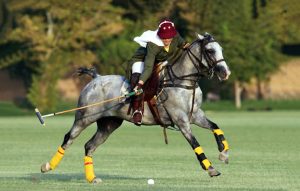Polo is one of the most entertaining sports to watch, combining the athleticism of both humans and horses. Currently a favourite sport of royalty and the elite, various forms of the game have been played for thousands of years dating back to the 6th-Century BC. The sport can be somewhat confusing for the uninitiated, so to help you get started in the world of polo here is a simple guide to the game!
A Long History
Historians suspect that polo originated in Persia (Modern Iran) approximately 2,600 years ago. It was originally played as both a sport and as a way to prepare for war — training horses to quickly turn and attack an objective. The early incarnations of polo were said to have up to 100 men per team, making the game very chaotic and often very violent.
Polo became extremely popular in the region and was exported to other countries including Tibet, China, Japan and India. There are many historical accounts of royalty and famous generals enjoying polo. Emperor Alexander of the Byzantine empire enjoyed it so much that he died of exhaustion while playing it!
The Modern Incarnation of Polo
The modern incarnation of polo began to take shape in Northern India, where Manipur tribesman played on a regular basis. The game was known by many different names including “Sagol Kangjei”, “Kanjai-bazee” and “Pulu”. The word Pulu referred to the wooden ball that was used in matches. That word eventually formed the commonly used “Polo”. British military officers saw the game being played in the early 19th-Century and by 1862 they had formed the Calcutta Polo Club.

The Manipur version of the game involved 7 players per side, riding short horses which were no more than 13 hands high (approximately 132 cm). Sides would score by knocking the ball out of either end of the field. Players could pick up the ball, but doing so meant they could be (painfully) tackled! Sticks were made of cane and balls were made from bamboo, allowing them to be hit for long distances. The horses wore colourful protective garment to guard vulnerable spots.
From India the game spread very quickly to other parts of the globe including Malta (1868), England (1869), Ireland (1870), Argentina (1872), Australia (1874) and the United States (1876). The Hurlingham Polo Association created the formal British rules in 1874, which the modern game is based upon.
Rules
The modern form of polo has 4 players per team. The rules for the game place a strict emphasis on the safety of both the players and the horses. A theory called the ‘line of the ball’ dictates what kind of strategic plays are allowed. The line of the ball is an imaginary line reflecting the trajectory the ball is taking. Every time the ball is hit the line of the ball changes and players must alter how they attack the ball.

The player who hits the ball has the right of way. Other players cannot block his path along the line of the ball and must instead ride parallel to the line of the ball. It is possible for a player to push a rider off the line of the ball, but they cannot directly block their path.
Hooking is a common technique in the game and involves a player using his or her mallet to prevent the swing of another player’s mallet. A player must be on the same side as the opponent’s mallet and not try to hook over the mount or in any dangerous manner.
Various penalties are applied in the event of unsafe play. A polo match typically lasts for 1.5 hours with six, seven-minute periods of play called “chukkers”. Between each chukker, there is a three-minute break with a five-minute half-time. The game clock is stopped when there is a foul, fall, loss of safety equipment or the ball rolls out of bounds.
Scoring is achieved by hitting the ball through the opponent’s goal. After each goal is scored, teams change ends to account for any wind advantage.
Polo Horses
Although the horses used in polo aren’t a specific breed, they must have certain traits to do well. Very often the quality of polo pony can determine which team wins the match, so a talented horse is highly valued by players.

Polo ponies must be highly intelligent to deal with the complexity of the match and the frequent commands that the rider is giving it. They must also be able to get to high speeds very quickly and have the ability to turn in tight circles.
To obtain those traits, polo horses are usually Arabian breeds for their intelligence and thoroughbreds for their high speed and power. The horses are bred to be more compact in size which allows them to gain speed and turn quickly. The English have been breeding polo ponies for hundreds of years to improve their traits for polo. A small thoroughbred stallion named Rosewater holds the title of “foundation sire” for most polo ponies.
In the United States, polo ponies are a mix of thoroughbred horses bred with quarter horses to obtain additional speed off the mark. In Argentina, the locals breed their thoroughbred horses with Criollo horses for the same reason.
Famous Players
Many members of the British royal family have been avid polo players including Prince Charles, Prince William and Prince Harry.

Many celebrities also love the game including some unusual ones! Sylvester Stallone, Tommy Lee Jones, Bing Crosby, Clark Gable, Conan O’Brian and even Arnold Schwarzenegger have all enjoyed playing the sport.
Now that you understand the basics of polo, attend a match and enjoy the beautiful horses and athletic players!
You can make you visit extra special, kate and toms property Jacobean Hall is local to a Polo pitch so you can try yourself or if you prefer just watch!



